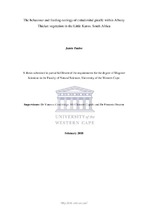| dc.description.abstract | Due to their popularity for tourism, giraffes are being introduced into Thicket areas within the Little Karoo region of the Western Cape. However, information regarding the activity budgets and diet selection of these giraffes is lacking. Therefore, this study aimed to achieve three objectives; to determine the diurnal activity budget, diet composition and browsing levels, and the estimated browsing capacities of extralimital giraffe. The study was conducted on two privately owned farms, namely Kareesbos Private Game Reserve and Tsumkwe Private Game Reserves. Observations were completed on both study sites using the interval scan method, whereby observations were conducted on all visible individuals from 6 am – 6 pm for four days every 3 months (winter, spring, summer and autumn). Observations found browsing to be the most dominant activity displayed by both populations, with walking and rumination being the second and third most dominant activity. Females browsed more than males in both study sites.
Dietary observations showed four species (Pappea capensis, Portulacaria afra, Euclea undulata and Searsia longispina) and five species (Searsia longispina, Euclea undulata, Pappea capensis, Vachellia karroo and Grewia robusta) to comprise approximately 90% and 80% of their diet in Kareesbos and Tsumkwe respectively. The importance of flower bearing species (Lycium spp. and Rhigozhum obovatum) increased during the spring and summer seasons in both study sites. In addition to the diet selection, browsing by both giraffe populations was shown to occur mostly below 2 m.
Estimated browsing capacities for Kareesbos and Tsumkwe were 25 and 21, and 107 and 88 ha per giraffe, respectively, for the respective browse height strata of less than two metres and five metres. It is suggested that browsing capacities of less than two metres be considered when stocking giraffe and the number of individuals adjusted accordingly on each farm, due to the continuous low browsing of giraffe at less than two metres. Furthermore, results indicate that these giraffes have adapted to take advantage of forage available in ecosystems outside their natural ranges. Low foraging heights suggests possible niche overlap with other browsers, which may result in increased competition for food when it becomes limited. Long term ecological monitoring of extralimital populations and appropriate management procedures are therefore required to avoid the displacement and degradation of indigenous fauna and flora within the Little Karoo, and possible mortalities amongst the giraffe populations. | en_US |

